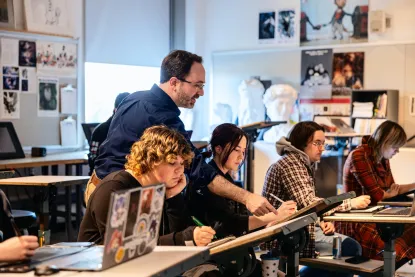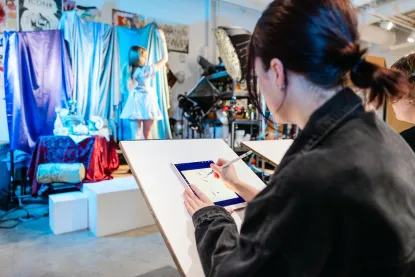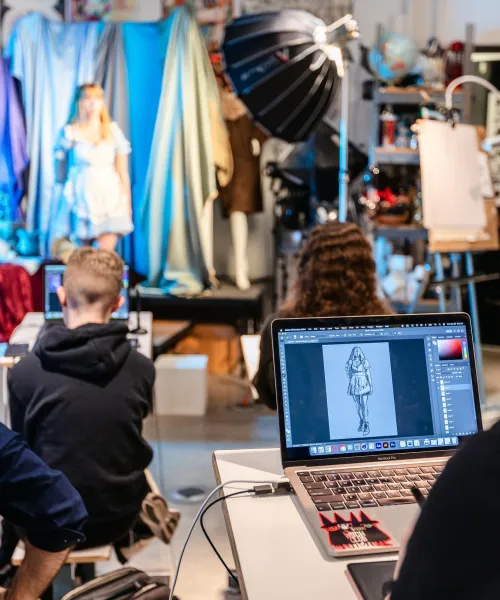Quick Links

The Illustration Major at NMU
Students in the Illustration program learn to communicate ideas and narratives visually for print and digital platforms. With the plethora of visual information encountered daily in movies, television, games, and online, illustrators clearly play essential roles in our increasingly visual hungry society. Common industries that commission freelance illustration or employ illustrators include advertising, editorial, book, comic, entertainment, medicine, biology, fashion, and architecture. An illustration graduate will have experience in various illustration forms to ensure that they can solve problems for many different clients. Students learn to develop original content, adding their distinct voices to visual culture.
An emphasis on working from life and direct observation of the subject is an essential part of the illustration curriculum. In AD219 Illustration: Foundations an understanding of the basic visual language of design, color, and linear perspective is acquired through projects related to the publishing, editorial, and concept art markets. Digital media is emphasized as an illustration tool during AD319A Illustration: Digital Media, while in AD319B Illustration: Narrative Figure students develop an understanding of the human figure necessary for artists and apply that knowledge to more conceptual and narrative work. In AD 419 Illustration: Advanced Studio, emphasis is placed on personal discovery and the development of self-authored content. The AD 431 Portfolio: Illustration and Painting coursework focuses on a specific area within the illustration or painting marketplace that interests the student, enabling the creation of a professional portfolio.
Class instruction addresses a range of media and techniques. Demonstrations, lectures, and art history examples are offered to illuminate technical issues and encourage exploration. Students are exposed to an atmosphere of creative thinking and critical analysis while being encouraged to develop an understanding of visual media. Through regular critique and discussion, students actively examine and respond to the work of their peers. The studio classroom functions best when it becomes a small artistic community where ideas and methods can be shared and discussed without prejudice. Ultimately, the skills and concepts that the students obtain early on will introduce them to the rewards and challenges of the creative process and help form the groundwork for more advanced ideas.
Illustration Faculty
Illustration Courses
ARTD 219 Illustration: Foundations
4 credit hours
Offered: Fall, Winter
Introduction to the fundamental principles and techniques of illustration, with a focus on narrative picture-making using ink and watercolor media.
AD 319A Illustration: Digital Media
4 credit hours
Offered: Fall, Winter
Prerequisite: AD 102 or AD 219, and AD 218; or instructor permission.
Digital media is employed as a tool for storytelling and visual communication, tailored to meet client needs. Explore how images effectively convey social messages through real-world illustration projects.
AD 319B Illustration: Narrative Figure
4 credit hours
Offered: Fall, even-numbered years
Prerequisite: AD 102 or AD 219 or instructor permission.
Exploration of the human figure as a structural form and vehicle for expression in narrative art and illustration. Emphasis is placed on anatomy, drawing, and painting from observation, construction, gesture, composition, research, and creating reference to aid imagination.
AD 419 Illustration: Advanced Studio
4 credit hours
Offered: Fall, odd-numbered years
Prerequisite: AD 303 or concurrent enrollment, and either AD 319A or AD 319B; or instructor’s permission.
Development of conceptual and problem-solving abilities within the framework of varied commercial situations, while encouraging personal artistic voice. Ideation, research, and the professional practice of an illustrator are emphasized.
AD 431 Portfolio: Illustration & Painting
4 credit hours
Offered: Winter, odd-numbered years
Prerequisite: AD 303, and at least two from AD319A, AD319B, AD320, AD419, or AD420; or instructor's permission.
Through individualized projects, students will refine their technical skills, artistic vision, and professional presentation to create portfolios and promotional materials that reflect their career goals and unique strengths.

Illustration Studio
The Illustration studio is located on the second floor of the Art & Design Building. The large multi-purpose studio has both natural and artificial light available. In addition to regular class hours, the studio is available to illustration students during evenings and weekends. Flat-file storage, sink, still life props, plaster casts, light tables, and Wacom Cintiqs help foster a professional studio environment for traditional or digital media.
Illustration FAQ
What is the difference between a Bachelor of Fine Arts (BFA) in Illustration and a Bachelor of Arts (BA)or Bachelor of Science (BS)?
The BFA is considered the professional studio degree, as it has more credits in the illustration concentration and more studio credit hours than a BA or BS degree. The BA and BS degrees provide students with the option to pursue a minor in another area of interest, such as Writing, English, etc., alongside their major in Illustration.
Does the school require a portfolio review before you are accepted into our programs?
If you are accepted into the University, you can pursue a degree within the school. However, you can present a portfolio to the professor in your studio area who will use your work to gauge whether you should receive advanced placement credit (replaces course and credit hours) or a waiver (replaces course but not the credit hours) or at what studio level you should begin. This portfolio can be reviewed during a campus visit or with a faculty member during a meeting during the semester. Although there is no required portfolio review to enter the program, Art and Design majors must participate and complete a faculty review of their portfolios (AD 303 Individual Art Review) which is usually scheduled during their junior year.
For information on general University admission requirements, contact the Admissions Office.
What equipment is required for Illustration majors?
Outside of the A&D Apple laptop requirement, complete with industry standard Adobe software, illustration students in AD319A Illustration: Digital Media will be required to purchase a digital drawing tablet or iPad. Besides digital tools, classes also utilize a range of traditional media throughout the curriculum, including: graphite, charcoal, ink, watercolor, colored pencil, pastels, collage, acrylic, and options to explore additional media as student interest dictates.
What are the prospects for employment with a degree in Illustration?
Earning a living as an illustrator today is achievable with the right mindset, preparation, and entrepreneurial spirit. Our graduates frequently work as freelance artists and illustrators, collaborating with a wide range of clients across industries on a project-by-project basis. This career path is full of exciting opportunities, though it can understandably feel overwhelming at times, both for students and their families. That’s why our curriculum is designed to prepare students not just artistically, but professionally. We provide essential training in areas like marketing their work, effective contract negotiation, safeguarding intellectual property rights, setting sustainable pricing, and maintaining high ethical standards. These real-world skills are foundational for launching and sustaining a successful creative career. But just as important as technical training is a student’s internal drive. No curriculum can replace qualities like self- discipline, persistence, and a willingness to grow from setbacks. These qualities are paramount in giving them the best possible chance of success. Rest assured, our program is designed not only to nurture artistic talent but also to instill the determination and adaptability necessary to thrive in the ever-evolving world of illustration.
What will I study in the Illustration program?
Our illustration curriculum places a strong emphasis on working from life and developing keen observational skills. This foundational approach helps students build essential techniques that strengthen their ability to visually communicate ideas and narratives across a wide range of media, including both print and digital platforms. While students are encouraged to pursue specialized areas of interest, our program also provides broad exposure to the many professional paths within the illustration field. This range of experience is invaluable in preparing students to excel in a continuously evolving job market. To further this goal, we actively encourage students to cultivate their own original content and personal projects. Students gain greater creative control and confidence in their work which fosters a spirit of artistic independence that is key for a lasting and meaningful career in illustration.
Are there scholarships available for incoming first-year students?
The school offers the High School Freshman Scholarship (four $1000 awards) that is available each year with applications due in April.
For information about scholarships for incoming freshmen, please visit the Scholarships & Financial Aid page.
